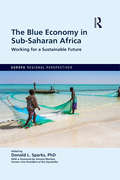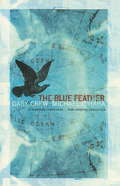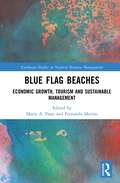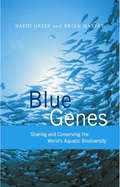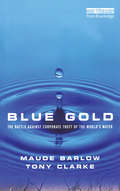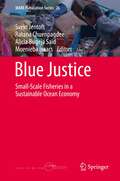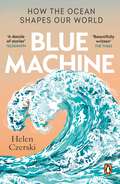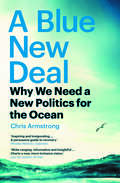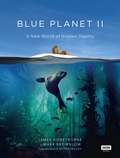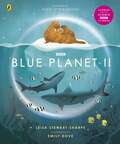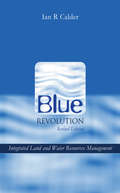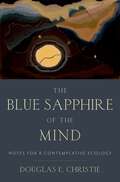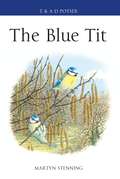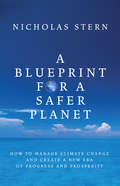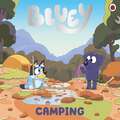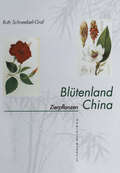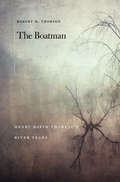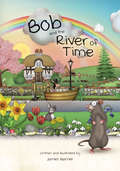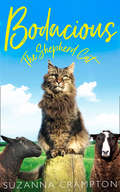- Table View
- List View
The Blue Economy in Sub-Saharan Africa: Working for a Sustainable Future (Europa Regional Perspectives)
by Donald L. SparksThe blue economy, comprising coastal and marine resources, offers vast benefits for sub-Saharan Africa: of the 53 countries and territories in the region, 32 are coastal states; there are 13 million sq km of maritime zones; more than 90% of the region’s exports and imports come by sea; and the African Union hails the blue economy as the ‘new frontier of African renaissance’. Despite their importance, the region’s coastal and marine resources have been neither fully appreciated nor fully utilized. They are only now being recognized as being key to Africa’s potential prosperity. As the region grows, it has, in general, not taken adequate safeguards to protect these valuable resources. That is partly because some of the problems (pollution, for example) are regional and know no borders. All too often, short-term gains are made at the expense of the long term (overfishing, for example). This book provides, for the first time, a study of the constraints and opportunities the blue economy offers for sub-Saharan Africa. It includes an introduction and overview; sectoral analyses (including tourism, fisheries, mineral resources, culture, shipping and maritime safety); country case studies; and analyses of regional and international efforts towards better coastal zone and marine management.
Blue Feather
by Gary CrewThere's a myth in Esperance that's been around for years, apparently going as far back as the arrival of the first Europeans. Locals think there's a huge bird, big enough to carry away adult humans . . .Blue Feather is a stunningly crafted mystery from one of Australia's most awarded writers, Gary Crew.Recurring rumours of attacks by a giant raptor lead Greg Muir to seek the truth behind the bird's existence. Is it big enough to bring down a light plane? Can it carry away human beings in its talons? Is it responsible for the mutilation of a hang-glider?A quest for a creature as fearful as it is elusive . . . Is the story of the huge bird only a myth, or is it reality? And if it is a reality, what part will it play in shaping the lives of those who search for it?'beautifully crafted novel . . . Fully satisfying' - Herald Sun
Blue Feather
by Gary CrewThere's a myth in Esperance that's been around for years, apparently going as far back as the arrival of the first Europeans. Locals think there's a huge bird, big enough to carry away adult humans . . .Blue Feather is a stunningly crafted mystery from one of Australia's most awarded writers, Gary Crew.Recurring rumours of attacks by a giant raptor lead Greg Muir to seek the truth behind the bird's existence. Is it big enough to bring down a light plane? Can it carry away human beings in its talons? Is it responsible for the mutilation of a hang-glider?A quest for a creature as fearful as it is elusive . . . Is the story of the huge bird only a myth, or is it reality? And if it is a reality, what part will it play in shaping the lives of those who search for it?'beautifully crafted novel . . . Fully satisfying' - Herald Sun
Blue Flag Beaches: Economic Growth, Tourism and Sustainable Management (Earthscan Studies in Natural Resource Management)
by María A. Prats Fernando MerinoThis book presents a comprehensive study of the role that the Blue Flag beach program has played around the world, considering economic, social and environmental perspectives. Since its creation in the 1980s, The Blue Flag program awards the management of beaches and marinas based on sustainability, services and quality of their management. To date there are currently close to five thousand awards around the world. Forty years on from the program's creation, this book provides a thorough evaluation of the program, to understand how it has evolved over time, the successes it has enjoyed and the challenges it has overcome, and may face in the future. As an international program, this book reflects the global nature of this program and actively discusses, examines and assesses the different realities and challenges faced by different countries around the world, drawing on case studies from across Europe, North America, Latin America, Africa and Asia. It examines the impact of the award on economic growth, from local to national, environmental protection and education, the development of sustainable tourism, and the sustainable management of beaches. The volume also contributes to emerging debates surrounding the certification of natural resources, where the Blue Flag program has been a pioneer in this field. This book will be of great interest to students and scholars of sustainable tourism, environmental economics, coastal and beach management, environmental conservation and sustainable development.
Blue Flag Beaches: Economic Growth, Tourism and Sustainable Management (Earthscan Studies in Natural Resource Management)
This book presents a comprehensive study of the role that the Blue Flag beach program has played around the world, considering economic, social and environmental perspectives. Since its creation in the 1980s, The Blue Flag program awards the management of beaches and marinas based on sustainability, services and quality of their management. To date there are currently close to five thousand awards around the world. Forty years on from the program's creation, this book provides a thorough evaluation of the program, to understand how it has evolved over time, the successes it has enjoyed and the challenges it has overcome, and may face in the future. As an international program, this book reflects the global nature of this program and actively discusses, examines and assesses the different realities and challenges faced by different countries around the world, drawing on case studies from across Europe, North America, Latin America, Africa and Asia. It examines the impact of the award on economic growth, from local to national, environmental protection and education, the development of sustainable tourism, and the sustainable management of beaches. The volume also contributes to emerging debates surrounding the certification of natural resources, where the Blue Flag program has been a pioneer in this field. This book will be of great interest to students and scholars of sustainable tourism, environmental economics, coastal and beach management, environmental conservation and sustainable development.
Blue Genes: Sharing and Conserving the World's Aquatic Biodiversity
by Brian HarveyThe advance of genetic sciences has led to a 'blue revolution' in the way we use aquatic biodiversity. By 2020, the world will be eating almost as much farmed as wild fish, marine bacteria could yield the cure for cancer and deep-sea bacteria may be exploited to gobble up oil spills. Science is moving ahead at a staggering speed, and the demand for genetic resources is growing rapidly - yet governance and policy lag far behind. This groundbreaking work is the first to look at the ownership, governance and trade in aquatic genetic resources. Blue Genes describes the growing demand for aquatic genetic resources and the desperate need to fill the policy vacuum about the management and conservation of aquatic biodiversity, which would help create a foundation for rules dictating access to, and use of, aquatic genetic resources. Special attention is paid to indigenous and local people having the right to access these resources and their role in managing and conserving aquatic biodiversity. The book concludes with policy recommendations specifically tailored to aquatic resources, with the use of six case studies from four continents to illustrate key issues.
Blue Genes: Sharing and Conserving the World's Aquatic Biodiversity
by Brian HarveyThe advance of genetic sciences has led to a 'blue revolution' in the way we use aquatic biodiversity. By 2020, the world will be eating almost as much farmed as wild fish, marine bacteria could yield the cure for cancer and deep-sea bacteria may be exploited to gobble up oil spills. Science is moving ahead at a staggering speed, and the demand for genetic resources is growing rapidly - yet governance and policy lag far behind. This groundbreaking work is the first to look at the ownership, governance and trade in aquatic genetic resources. Blue Genes describes the growing demand for aquatic genetic resources and the desperate need to fill the policy vacuum about the management and conservation of aquatic biodiversity, which would help create a foundation for rules dictating access to, and use of, aquatic genetic resources. Special attention is paid to indigenous and local people having the right to access these resources and their role in managing and conserving aquatic biodiversity. The book concludes with policy recommendations specifically tailored to aquatic resources, with the use of six case studies from four continents to illustrate key issues.
Blue Gold: The Battle Against Corporate Theft of the World's Water
by Maude Barlow Tony ClarkeInternational tensions around water are rising in many of the world's most volatile regions. The policy recipe pursued by the West, and imposed on governments elsewhere, is to pass control over water to private interests, which simply accelerates the cycle of inequality and deprivation. California, as well as China, South Africa, Mexico and countries on every continent already face a crisis. This book exposes the enormity of the problem, the dangers of the proposed solution and the alternative, which is to recognize access to water as a fundamental human right, not dependent on ability to pay.
Blue Gold: The Battle Against Corporate Theft of the World's Water
by Maude Barlow Tony ClarkeInternational tensions around water are rising in many of the world's most volatile regions. The policy recipe pursued by the West, and imposed on governments elsewhere, is to pass control over water to private interests, which simply accelerates the cycle of inequality and deprivation. California, as well as China, South Africa, Mexico and countries on every continent already face a crisis. This book exposes the enormity of the problem, the dangers of the proposed solution and the alternative, which is to recognize access to water as a fundamental human right, not dependent on ability to pay.
Blue Justice: Small-Scale Fisheries in a Sustainable Ocean Economy (MARE Publication Series #26)
by Svein Jentoft Ratana Chuenpagdee Alicia Bugeja-Said Moenieba IsaacsFor small-scale fisheries around the world, the Blue Growth and Blue Economy initiatives may provide sustainable development, but only insofar as they align with the global consensus enshrined in the Voluntary Guidelines for Securing Sustainable Small-Scale Fisheries in the context of Food Security and Poverty Eradication. If states do nothing to fulfill the promises they made when they endorsed these guidelines in 2014, the Blue Economy will come at a loss for small-scale fisheries and further their marginalization in the ocean economy. Under the umbrella of Blue Justice, this book demonstrates that these risks are real and must be considered as states implement their sustainable ocean development plans. These are human rights issues, which are embedded into governance principles and institutions and which make a difference for small-scale fisheries people in their daily lives. In stressing the importance of policies and institutions that build on the experiences of small-scale fisheries people in the contexts in which they operate, this book draws on case studies of small-scale fisheries from countries on all continents to clarify what Blue Justice entails for small-scale fisheries and make suggestions for real change. “Through the Blue Justice paradigm, this book flags the relevance of recognizing the potential impact that different factors, including the Blue Economy approach, could bring to fishing communities, their livelihoods, cultural traditions, and other potential multidimensional conflicts. Vulnerability in fishing communities can increase and inequalities can be reinforced at different levels if individuals and community capabilities are not strengthened… A first of its kind, not to be missed, this book is informative, purposeful, and pertinent in an era of change”. Silvia Salas, CINVESTAV, Marine Resources Department, Mérida, Mexico "The studies reveal that Blue Justice is a ‘governability’ issue, which requires establishing ‘right’ institutions, that are transdisciplinary (integrated), participatory, and holistic. It is implicit from these writings that the SSF Guidelines and Blue Growth initiatives do not form two different discourses, and that the implementation of the former would resolve many of the justice issues caused by the latter, in favor of small-scale fisheries and their communities". Oscar Amarasinghe, Professor & Chancellor, Ocean University of Sri Lanka and President, Sri Lanka Forum for Small Scale Fisheries (SLFSSF)
Blue Machine: How the Ocean Shapes Our World
by Helen CzerskiFINANCIAL TIMES 2023 HIGHLIGHT'Helen Czerski weaves together physics and biology, history and science, in a beautifully poetic way.'Professor Alice Roberts'In Helen Czerski's hands, the mechanical becomes magical. An instant classic.'Tristan Gooley, author of How to Read Water'Blue Machine is quite simply one of the best books I have ever read.'Dr George McGavin, zoologist, entomologist and broadcaster'A fascinating dive into the essential engine that drives our world. Czerski brings the oceans alive with compelling stories that masterfully navigate this most complex system.'Gaia Vince, science journalist, broadcaster and author of Nomad Century All of the Earth's ocean, from the equator to the poles, is a single engine powered by sunlight - a blue machine.Earth is home to a huge story that is rarely told - that of our ocean. Not the fish or the dolphins, but the massive ocean engine itself: what it does, why it works, and the many ways it has influenced animals, weather and human history & culture.In a book that will recalibrate our view of this defining feature of our planet, physicist Helen Czerski dives deep to illuminate the murky depths of the ocean engine, examining the messengers, passengers and voyagers that live in it, travel over it, and survive because of it. From the ancient Polynesians who navigated the Pacific by reading the waves to permanent residents of the deep such as the Greenland shark that can live for hundreds of years, she explains the vast currents, invisible ocean walls and underwater waterfalls that all have their place in the ocean's complex, interlinked system.Timely, elegant and passionately argued, Blue Machine presents a fresh perspective on what it means to be a citizen of an ocean planet. The understanding it offers is crucial to our future. Drawing on years of experience at the forefront of marine science, Helen Czerski captures the magnitude and subtlety of Earth's defining feature, showing us the thrilling extent to which we are at the mercy of this great engine.
A Blue New Deal: Why We Need a New Politics for the Ocean
by Chris ArmstrongAn urgent account of the state of our oceans today—and what we must do to protect themThe ocean sustains life on our planet, from absorbing carbon to regulating temperatures, and, as we exhaust the resources to be found on land, it is becoming central to the global market. But today we are facing two urgent challenges at sea: massive environmental destruction, and spiraling inequality in the ocean economy.Chris Armstrong reveals how existing governing institutions are failing to respond to the most pressing problems of our time, arguing that we must do better. Armstrong examines these crises—from the fate of people whose lands will be submerged by sea level rise, to the exploitation of people working in fishing, to the rights of marine animals—and makes the case for a powerful World Ocean Authority capable of tackling them. A Blue New Deal presents a radical manifesto for putting equality, democracy, and sustainability at the heart of ocean politics.
Blue Planet II
by James Honeyborne Mark BrownlowTake a deep breath and dive into the mysteries of the ocean.Our understanding of ocean life has changed dramatically in the last decade, with new species, new behaviours, and new habitats being discovered at a rapid rate. Blue Planet II, which accompanies an epic 7-part series on BBC1, is a ground-breaking new look at the richness and variety of underwater life across our planet.From ambush hunters such as the carnivorous bobbit worm to cuttlefish mesmerising their prey with a pulsating light display, Blue Planet II reveals the never-before-seen secrets of the ocean. With over 200 breath-taking photographs and stills from the BBC Natural History Unit's spectacular footage, each chapter of Blue Planet II brings to life a different habitat of the oceanic world. Voyages of migration show how each of the oceans on our planet are connected; coral reefs and arctic ice communities are revealed as thriving underwater cities; while shorelines throw up continual challenges to those living there or passing through. A final chapter explores the science and technology of the Ocean enterprise – not only how they were able to capture these amazing stories on film, but what the future holds for marine life based on these discoveries.
Blue Planet II: For young wildlife-lovers inspired by David Attenborough's series (BBC Earth)
by Leisa Stewart-SharpeThis is our Blue Planet: a beautiful blue marble suspended in a sea of stars.Unlike billions of other worlds in the Milky Way, 71 per cent of our Blue Planet is covered by ocean. It's home to the greatest diversity of life on Earth but is our least explored habitat; we've better maps of Mars than of the ocean floor.With so much more to discover, take a deep breath . . . and dive into a wondrous world beneath the waves.Explore coral reefs that shimmer in a kaleidoscope of colours.Venture to the bottom of the ocean where creatures beyond your wildest imagination live in the dark.Chase sea otters through kelp forest seas, and glide the open ocean with humpback whales.Discover all there is to love about our Blue Planet, the stories of its inhabitants, and realise how you can help protect this wilderness beneath the waves.In collaboration with BBC Earth, this illustrated non-fiction book will capture the wonder, beauty, and emotion of the landmark Blue Planet II TV series.
Blue Revolution: Integrated Land and Water Resources Management
by Ian Calder'Blue Revolution upturns some environmental applecarts - not for the hell of it, but so we can manage our environment better.' Fred Pearce, New Scientist This updated and revised edition of The Blue Revolution provides further evidence of the need to integrate land management decision-making into the process of integrated water resources management. It presents the key issues involved in finding the balance between the competing demands for land and water: for food and other forms of economic production, for sustaining livelihoods, and for conservation, amenity, recreation and the requirements of the environment. It also advocates the means and methodologies for addressing them. A new chapter, 'Policies, Power and Perversity,' describes the perverse outcomes that can result from present, often myth-based, land and water policies which do not consider these land and water interactions. New research and case studies involving ILWRM concepts are presented for the Panama Canal catchments and in relation to afforestation proposals for the UK Midlands.
Blue Revolution: Integrated Land and Water Resources Management
by Ian Calder'Blue Revolution upturns some environmental applecarts - not for the hell of it, but so we can manage our environment better.' Fred Pearce, New Scientist This updated and revised edition of The Blue Revolution provides further evidence of the need to integrate land management decision-making into the process of integrated water resources management. It presents the key issues involved in finding the balance between the competing demands for land and water: for food and other forms of economic production, for sustaining livelihoods, and for conservation, amenity, recreation and the requirements of the environment. It also advocates the means and methodologies for addressing them. A new chapter, 'Policies, Power and Perversity,' describes the perverse outcomes that can result from present, often myth-based, land and water policies which do not consider these land and water interactions. New research and case studies involving ILWRM concepts are presented for the Panama Canal catchments and in relation to afforestation proposals for the UK Midlands.
The Blue Sapphire of the Mind: Notes for a Contemplative Ecology
by Douglas E. Christie"There are no unsacred places," the poet Wendell Berry has written. "There are only sacred places and desecrated places." What might it mean to behold the world with such depth and feeling that it is no longer possible to imagine it as something separate from ourselves, or to live without regard for its well-being? To understand the work of seeing things as an utterly involving moral and spiritual act? Such questions have long occupied the center of contemplative spiritual traditions. In The Blue Sapphire of the Mind, Douglas E. Christie proposes a distinctively contemplative approach to ecological thought and practice that can help restore our sense of the earth as a sacred place. Drawing on the insights of the early Christian monastics as well as the ecological writings of Henry David Thoreau, Aldo Leopold, Annie Dillard, and many others, Christie argues that, at the most basic level, it is the quality of our attention to the natural world that must change if we are to learn how to live in a sustainable relationship with other living organisms and with one another. He notes that in this uniquely challenging historical moment, there is a deep and pervasive hunger for a less fragmented and more integrated way of apprehending and inhabiting the living world--and for a way of responding to the ecological crisis that expresses our deepest moral and spiritual values. Christie explores how the wisdom of ancient and modern contemplative traditions can inspire both an honest reckoning with the destructive patterns of thought and behavior that have contributed so much to our current crisis, and a greater sense of care and responsibility for all living beings. These traditions can help us cultivate the simple, spacious awareness of the enduring beauty and wholeness of the natural world that will be necessary if we are to live with greater purpose and meaning, and with less harm, to our planet.
The Blue Tit
by Martyn StenningSporting a mix of blue, yellow, white, green and black, the unmistakable Blue Tit reflects the colours of a planet affected by a burgeoning human population. Fortunately, Blue Tits are adapting well to modern humanity, taking advantage of our propensity to feed birds in our gardens and provide boxes for them to nest in. In turn, this feisty little species provides an excellent model for biological research. This book is the result of a personal quest by author Martyn Stenning to bring together a range of discoveries into one accessible volume.The Blue Tit begins by inviting readers into the intimate lives of these birds as they attempt to reproduce, describing the many challenges they face when rearing their offspring. The story moves on to the fluid state of Blue Tit classification across the native Palearctic range, before progressing into population structure, lifetime ecology and an exploration of factors that determine breeding success. It culminates with an in-depth look at research over the years, followed by a selection of personal anecdotes and an overview of Blue Tit appearances in folklore and poetry.This book provides a definitive record of the biology and ecology of one of our most popular, intelligent and charismatic birds.
The Blue Tit
by Martyn StenningSporting a mix of blue, yellow, white, green and black, the unmistakable Blue Tit reflects the colours of a planet affected by a burgeoning human population. Fortunately, Blue Tits are adapting well to modern humanity, taking advantage of our propensity to feed birds in our gardens and provide boxes for them to nest in. In turn, this feisty little species provides an excellent model for biological research. This book is the result of a personal quest by author Martyn Stenning to bring together a range of discoveries into one accessible volume.The Blue Tit begins by inviting readers into the intimate lives of these birds as they attempt to reproduce, describing the many challenges they face when rearing their offspring. The story moves on to the fluid state of Blue Tit classification across the native Palearctic range, before progressing into population structure, lifetime ecology and an exploration of factors that determine breeding success. It culminates with an in-depth look at research over the years, followed by a selection of personal anecdotes and an overview of Blue Tit appearances in folklore and poetry.This book provides a definitive record of the biology and ecology of one of our most popular, intelligent and charismatic birds.
A Blueprint for a Safer Planet: How to Manage Climate Change and Create a New Era of Progress and Prosperity
by Nicholas Stern* Further substantial climate change is unavoidable and the risks to the natural world, the economy and our everyday lives are immense. The way we live in the next thirty years - how we invest, use energy, organise transport and treat forests - will determine whether these risks become realities.* Although poor countries - the least responsible for climate change - will be hit earliest and hardest, all countries must adapt to the effects: hurricanes and storms strike New Orleans and Mumbai; flooding causes devastation in England and Mozambique; droughts occur in Australia and Darfur; and sea level rise will affect Florida and Bangladesh. * Lord Stern, author of the Stern Review on the Economics of Climate Change and former Chief Economist at the World Bank, is the world's leading authority on what we can do in the face of such unprecedented threat. Action on climate change will require the greatest possible international collaboration, but if successful will ensure not just our future, but our future prosperity. * Focusing on the economic management of investment and growth from the perspective of both adaptation and mitigation, Stern confronts the most urgent questions facing us now: what is the problem? What are the dangers? What can be done to reduce emissions, at what cost? How can the world adapt? And what does all this mean for corporations, governments and individuals? * A Blueprint for a Safer Planet provides authoritative, inspirational, and hopeful, answers.
Bluey: Camping (Bluey)
by BlueyBluey is on a family camping trip, where she makes a new friend, Jean-Luc.Even though Bluey and Jean-Luc don't speak the same language, they teach each other how to camp, plant trees and hunt a "wild pig". This lovely picture book is all about the magic of friendship.
Blütenland China Botanische Berichte und Bilder: I. Zierpflanzen: Vorkommen Symbolik Wirkstoffe
by Ruth Schneebeli-GrafThe Boatman: Henry David Theoreau's River Years
by Robert M. ThorsonRobert Thorson gives readers a Thoreau for the Anthropocene. The boatman and backyard naturalist was keenly aware of the way humans had altered the waterways and meadows of his beloved Concord River Valley. Yet he sought out for solace and pleasure those river sites most dramatically altered by human invention and intervention—for better and worse.
Bob and the River of Time
by James GarnerMeet Bob as he journeys along the magical River Mumbles, which flows through Grumbledown. The river takes Bob on an unexpected, topsy-turvy journey through the seasons, and on his way he sees a host of different creatures and plants. Bob and the River of Time is a fantastical, educational picture book written and illustrated by James Garner. It is a charming, fun short story ideal for entertaining and inspiring children (it's suitable for children aged 3 years and upwards). At the same time, the characters, scenery and changing seasons Bob encounters on his journey will teach children about wildlife and nature. Bob and the River of Time introduces children to the weather, the four seasons and plant and animal life, and also teaches the importance of maintaining a positive outlook when you aren't sure where your journey is taking you. The book is beautifully illustrated with over 100 real-life animal characters, with detailed information about each one at the back of the book. This attention to detail ensures that each time you open the book you'll discover something new and the calming flow of the story will send children to a place of tranquil and inspired imagination. Searching for the many creatures and plants within the book is a great way to focus a child's mind, especially if their mind has a tendency to wander! Bob and the River of Time is a story full of wandering and wondering. Join Bob as he learns one of the most simple, eloquent and powerful lessons life can teach. For children age 3+ years.
Bodacious: The Shepherd Cat
by Suzanna CramptonBODACIOUS: THE SHEPHERD CAT is a heart-warming and charming tale in which Bodacious tells us about life as The Shepherd Cat on Black Sheep Farm.
